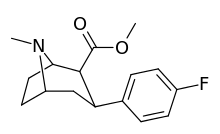WIN-35428
(–)-2-β-Carbomethoxy-3-β-(4-fluorophenyl)tropane (β-CFT, WIN 35,428) is a stimulant drug used in scientific research. CFT is a phenyltropane based dopamine reuptake inhibitor and is structurally derived from cocaine. It is around 3-10x more potent than cocaine and lasts around 7 times longer based on animal studies. While the naphthalenedisulfonate salt is the most commonly used form in scientific research due to its high solubility in water, the free base and hydrochloride salts are known compounds and can also be produced. The tartrate is another salt form that is reported.[1]
 | |
| Clinical data | |
|---|---|
| Other names | CFT, WIN 35,428 |
| Identifiers | |
IUPAC name
| |
| CAS Number |
|
| PubChem CID | |
| IUPHAR/BPS | |
| ChemSpider | |
| ChEMBL | |
| CompTox Dashboard (EPA) | |
| ECHA InfoCard | 100.164.866 |
| Chemical and physical data | |
| Formula | C16H20FNO2 |
| Molar mass | 277.33 g/mol (free base); 565.55 g/mol (anhydrous naphthalenedisulfonate) g·mol−1 |
| 3D model (JSmol) | |
| Specific rotation | -62.5° |
| Melting point | 202 to 204 °C (396 to 399 °F) |
SMILES
| |
InChI
| |
| | |
Uses
CFT was first reported by Clarke and co-workers in 1973.[2] This drug is known to function as a "positive reinforcer" (although it is less likely to be self-administered by rhesus monkeys than cocaine).[1] Tritiated CFT is frequently used to map binding of novel ligands to the DAT, although the drug also has some SERT affinity.
Radiolabelled forms of CFT have been used in humans and animals to map the distribution of dopamine transporters in the brain. CFT was found to be particularly useful for this application as a normal fluorine atom can be substituted with the radioactive isotope 18F which is widely used in Positron emission tomography. Another radioisotope-substituted analog [11C]WIN 35,428 (where the carbon atom of either the N-methyl group, or the methyl from the 2-carbomethoxy group of CFT, has been replaced with 11C) is now more commonly used for this application, as it is quicker and easier in practice to make radiolabelled CFT by methylating nor-CFT or 2-desmethyl-CFT than by reacting methylecgonidine with parafluorophenylmagnesium bromide, and also avoids the requirement for a licence to work with the restricted precursor ecgonine.
CFT is about as addictive as cocaine in animal studies, but is taken less often due to its longer duration of action. Potentially this could make it a suitable drug to be used as a substitute for cocaine, in a similar manner to how methadone is used as a substitute for opiates in treating addiction.
Street drug
In August 2010, some media sources claimed that the designer drug Ivory Wave contained WIN 35,428.[3] However, samples of Ivory Wave have been found to contain MDPV,[4] so the legitimacy of these claims remains unclear.
Legal status
CFT is not specifically scheduled in the United States,[5] though it is considered by chemical supply companies and perhaps law enforcement to be covered under the Federal Analog Act as a Schedule II due to its close similarity in structure and function to the schedule II drug cocaine.[6][7]
Toxicity
Administering 100 mg/kg of CFT to rats only resulted in convulsions being reported, whereas CIT had the ability to cause death at this dose.
References
- Wee, S; Carroll, FI; Woolverton, WL (2006). "A reduced rate of in vivo dopamine transporter binding is associated with lower relative reinforcing efficacy of stimulants". Neuropsychopharmacology. 31 (2): 351–62. doi:10.1038/sj.npp.1300795. PMID 15957006.
- Clarke, RL; Daum, SJ; Gambino, AJ; Aceto, MD; Pearl, J; Levitt, M; Cumiskey, WR; Bogado, EF (1973). "Compounds affecting the central nervous system. 4. 3 Beta-phenyltropane-2-carboxylic esters and analogs". Journal of Medicinal Chemistry. 16 (11): 1260–7. doi:10.1021/jm00269a600. PMID 4747968.
- "Ivory Wave: The new meow meow?". Metro.co.uk. 2010-08-17. Retrieved 2010-08-23.
- Sam Jones and Mike Power (2010-08-17). "Ivory Wave drug implicated in death of 24-year-old man | Society | guardian.co.uk". London: Guardian. Retrieved 2010-08-23.
- "DEA, Drug Scheduling". Retrieved 2011-04-07.
- "Controlled Substances in Research Policy (Portland VA Medical Center)" (PDF). Retrieved 2010-08-23.
- "C124 β-CFT naphthalenedisulfonate monohydrate solid". Sigmaaldrich.com. Retrieved 2010-08-23.
- D'Mello, GD; Goldberg, DM; Goldberg, SR; Stolerman, IP (Dec 1979). "Conditioned taste aversion and operant behaviour in rats: effects of cocaine and a cocaine analogue (WIN 35,428)". Neuropharmacology. 18 (12): 1009–10. doi:10.1016/0028-3908(79)90167-9. PMID 530372.
- Reith, MEA; Sershen, H; Lajtha, A. (Sep 1980). "Saturable (3H)cocaine binding in central nervous system of mouse". Life Sciences. 27 (12): 1055–62. doi:10.1016/0024-3205(80)90029-6. PMID 6106874.
- Spealman, RD; Bergman, J; Madras, BK (Aug 1991). "Self-administration of the high-affinity cocaine analog 2 beta-carbomethoxy-3 beta-(4-fluorophenyl)tropane". Pharmacology Biochemistry and Behavior. 39 (4): 1011–3. doi:10.1016/0091-3057(91)90067-c.
- Milius, RA; Saha, JK; Madras, BK; Neumeyer, JL (1991). "Synthesis and Receptor Binding of N-Substituted Tropane Derivatives. High- Affinity Ligands for the Cocaine Receptor". Journal of Medicinal Chemistry. 34 (5): 1728–1731. doi:10.1021/jm00109a029. PMID 2033595.
- Cline, EJ; Scheffel, U; Boja, JW; Carroll, FI; Katz, JL; Kuhar, MJ (Mar 1992). "Behavioral effects of novel cocaine analogs: a comparison with in vivo receptor binding potency". Journal of Pharmacology and Experimental Therapeutics. 260 (3): 1174–9.
- Singh, S (2000). "Chemistry, Design, and Structure-Activity Relationship of Cocaine Antagonists". Chemical Reviews. 100 (3): 925–1024. doi:10.1021/cr9700538. PMID 11749256.
- Li, SM; Campbell, BL; Katz, JL (Jun 2006). "Interactions of cocaine with dopamine uptake inhibitors or dopamine releasers in rats discriminating cocaine". Journal of Pharmacology and Experimental Therapeutics. 317 (3): 1088–96. doi:10.1124/jpet.105.100594. PMID 16478825.
- Kline Jr, Richard H.; Wright, Jeremy; Fox, Kristine M.; Eldefrawi, Mohyee E. (1990). "Synthesis of 3- Arylecgonine Analogues as Inhibitors of Cocaine Binding and Dopamine Uptake". Journal of Medicinal Chemistry. 1990 (33): 2024–2027. doi:10.1021/jm00169a036. PMID 2362282.
- Xu L, Trudell ML. Journal of Heterocyclic Chemistry. 1996; 33: 2037.